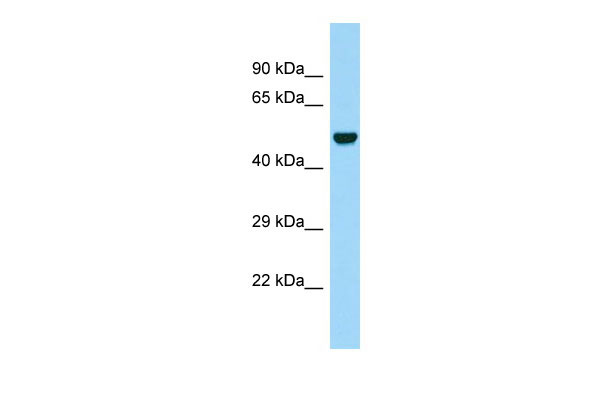LGMN Antibody - middle region
Rabbit Polyclonal Antibody
- SPECIFICATION
- CITATIONS
- PROTOCOLS
- BACKGROUND

Application
| WB |
|---|---|
| Primary Accession | Q99538 |
| Other Accession | NM_005606, NP_005597 |
| Reactivity | Human, Mouse, Rat, Rabbit, Pig, Sheep, Horse, Bovine, Guinea Pig, Dog |
| Predicted | Human, Mouse, Rat, Rabbit, Pig, Sheep, Horse, Bovine, Guinea Pig, Dog |
| Host | Rabbit |
| Clonality | Polyclonal |
| Calculated MW | 48kDa |
| Gene ID | 5641 |
|---|---|
| Alias Symbol | AEP, LGMN1, PRSC1 |
| Other Names | Legumain, 3.4.22.34, Asparaginyl endopeptidase, Protease, cysteine 1, LGMN, PRSC1 |
| Format | Liquid. Purified antibody supplied in 1x PBS buffer with 0.09% (w/v) sodium azide and 2% sucrose. |
| Reconstitution & Storage | Add 50 ul of distilled water. Final anti-LGMN antibody concentration is 1 mg/ml in PBS buffer with 2% sucrose. For longer periods of storage, store at 20°C. Avoid repeat freeze-thaw cycles. |
| Precautions | LGMN Antibody - middle region is for research use only and not for use in diagnostic or therapeutic procedures. |
| Name | LGMN {ECO:0000303|PubMed:30425301, ECO:0000312|HGNC:HGNC:9472} |
|---|---|
| Function | Has a strict specificity for hydrolysis of asparaginyl bonds (PubMed:23776206). Can also cleave aspartyl bonds slowly, especially under acidic conditions (PubMed:23776206). Involved in the processing of proteins for MHC class II antigen presentation in the lysosomal/endosomal system (PubMed:9872320). Also involved in MHC class I antigen presentation in cross-presenting dendritic cells by mediating cleavage and maturation of Perforin-2 (MPEG1), thereby promoting antigen translocation in the cytosol (By similarity). Required for normal lysosomal protein degradation in renal proximal tubules (By similarity). Required for normal degradation of internalized EGFR (By similarity). Plays a role in the regulation of cell proliferation via its role in EGFR degradation (By similarity). |
| Cellular Location | Lysosome. |
| Tissue Location | Ubiquitous. Particularly abundant in kidney, heart and placenta. |

Thousands of laboratories across the world have published research that depended on the performance of antibodies from Abcepta to advance their research. Check out links to articles that cite our products in major peer-reviewed journals, organized by research category.
info@abcepta.com, and receive a free "I Love Antibodies" mug.
Provided below are standard protocols that you may find useful for product applications.
References
Chen J.-M.,et al.J. Biol. Chem. 272:8090-8098(1997).
Tanaka T.,et al.Cytogenet. Cell Genet. 74:120-123(1996).
Li W.B.,et al.Submitted (JAN-2003) to the EMBL/GenBank/DDBJ databases.
Heilig R.,et al.Nature 421:601-607(2003).
Chen J.-M.,et al.Biochem. J. 352:327-334(2000).
If you have used an Abcepta product and would like to share how it has performed, please click on the "Submit Review" button and provide the requested information. Our staff will examine and post your review and contact you if needed.
If you have any additional inquiries please email technical services at tech@abcepta.com.













 Foundational characteristics of cancer include proliferation, angiogenesis, migration, evasion of apoptosis, and cellular immortality. Find key markers for these cellular processes and antibodies to detect them.
Foundational characteristics of cancer include proliferation, angiogenesis, migration, evasion of apoptosis, and cellular immortality. Find key markers for these cellular processes and antibodies to detect them. The SUMOplot™ Analysis Program predicts and scores sumoylation sites in your protein. SUMOylation is a post-translational modification involved in various cellular processes, such as nuclear-cytosolic transport, transcriptional regulation, apoptosis, protein stability, response to stress, and progression through the cell cycle.
The SUMOplot™ Analysis Program predicts and scores sumoylation sites in your protein. SUMOylation is a post-translational modification involved in various cellular processes, such as nuclear-cytosolic transport, transcriptional regulation, apoptosis, protein stability, response to stress, and progression through the cell cycle. The Autophagy Receptor Motif Plotter predicts and scores autophagy receptor binding sites in your protein. Identifying proteins connected to this pathway is critical to understanding the role of autophagy in physiological as well as pathological processes such as development, differentiation, neurodegenerative diseases, stress, infection, and cancer.
The Autophagy Receptor Motif Plotter predicts and scores autophagy receptor binding sites in your protein. Identifying proteins connected to this pathway is critical to understanding the role of autophagy in physiological as well as pathological processes such as development, differentiation, neurodegenerative diseases, stress, infection, and cancer.


